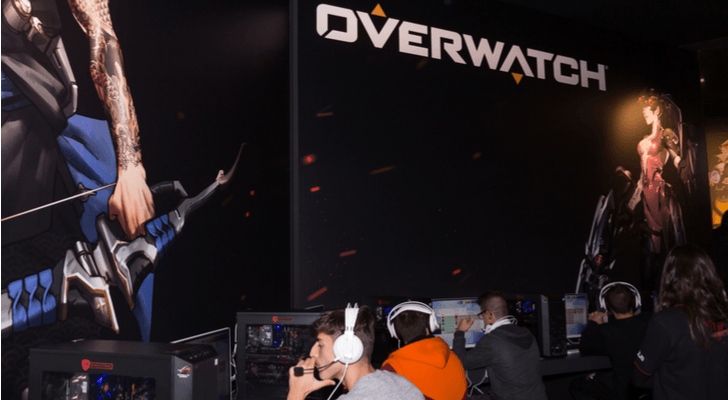I can see why an investor might want to buy the dip in Activision Blizzard (NASDAQ:ATVI) stock. Activision stock has been hammered of late, falling 36% in a month and a half. ATVI stock now trades at an 18-month low — and just 22x updated 2018 EPS guidance.
And the news doesn’t seem that bad. The long-term drivers behind the gaming industry remain intact. Activision’s Q3 earnings were fine. Guidance was disappointing, but Activision Blizzard has provided low guidance for years, so that shouldn’t necessarily be a surprise. There are some concerns here about the launch of Diablo Immortal on mobile and a near-term slowdown in growth. But given a still-strong balance sheet, the depth of the decline in ATVI stock hardly seems to match the importance of the news over the past 6-7 weeks.
The catch from my perspective, however, is that Activision stock was overpriced at October — and all-time — highs near $85. This remains a company dependent on mature, low-growth franchises. Earnings growth here has been minimal for years. Gaming industry headwinds may help, but I’d still rather own Electronic Arts (NASDAQ:EA) or Take-Two Interactive (NASDAQ:TTWO) — which I still think is the best play in the space. In contrast, Activision Blizzard charges a high price for low growth, as I argued last year.
In that context, 22x earnings isn’t that cheap. From here, the issue isn’t that Activision stock has fallen to $55 — it’s that it should have traded closer to that figure all along.
The Growth Problem for ATVI Stock
Over time, it looks as if Activision has been an impressive grower this decade. Non-GAAP EPS in calendar year 2010 was $0.79. 2018 guidance is for $2.46 per share, more than triple. That guidance suggests a 15% annual increase in earnings per share — an impressive accomplishment.
But on its own, Activision really hasn’t grown earnings very much at all. There have been three key events that boosted reported EPS. In 2013, the company bought back a huge chunk of shares from former majority shareholder Vivendi SA (OTCMKTS:VIVHY). That move cut the share count and even including interest expense boosted EPS by over 25%. In 2016, the company acquired Candy Crush-maker King Digital Entertainment. Both moves were at cut-rate prices. Vivendi sold its ATVI stock for just $13.60 per share and King, worried about a Candy Crush peak, sold itself for 6x EBITDA.
Both were great moves, admittedly. And combined with tax reform (which cut this year’s tax rate to ~18% from ~24% last year, both on an adjusted basis), they boosted earnings per share.
But on an operating basis, the performance is much, much less impressive:
- 2010: $991 million
- 2011: $1,087 million
- 2012: $1,350 million
- 2013: $999 million
- 2014: $1,057 million
- 2015: $975 million
- 2016: $1,659 million
- 2017: $1,656 million
- 2018 (based on company guidance): $1,899 million
Bear in mind that King generated over $600 million in net profit
itself in 2015. And revenue and profits have grown under Activision’s ownership, per ATVI filings. (It’s not disclosed whether profits have grown.)
Tax reform added ~$130 million to 2018 net income. Combined, that’s about 80% of the net income growth Activision Blizzard has generated over these eight years. Aside from those three factors, Activision Blizzard itself has grown earnings maybe 20% total — or about 2% a year.
Activision Stock Still Priced for Better
Certainly, it’s possible that earnings growth will accelerate. And to be fair, assuming Q4 guidance indeed is conservative, profit growth will be rather solid in 2018. (Pre-tax income should grow high single-digits.) The same move to digital downloads that is hurting GameStop (NYSE:GME) will help Activision Blizzard margins. Gaming demand should be solid, as seen in the big gains at chipmaker Nvidia (NASDAQ:NVDA).
That said, clearly investors are much more cautious about the market as a whole. ATVI stock has been the weakest performer in the space, but NVDA has been almost as bad, down 35% from its own early October highs. EA and TTWO all have sold off as well.
And for Activision in particular, the news looks grimmer. Two-thirds of revenue, per the 10-K, still comes from Call of Duty, Candy Crush, World of Warcraft and Overwatch. There simply isn’t much growth left in those franchises. And WoW, in particular, is in the middle of a long-term, if choppy, decline in its user base. The King segment has seen declining users, and profits and revenues declined year-over-year in Q3 according to the 10-Q. Call of Duty and Overwatch (aside from eGaming) probably don’t have much growth left.
There are growth drivers here, whether it’s eGaming, Diablo Immortal, or margin expansion potential from more digital downloads and more in-game monetization. But with two-thirds of the portfolio basically stagnant — the four games combined increased GAAP sales 1-2% in 2017, based on figures from the 10-K — it takes a lot from the remaining one-third to drive real earnings growth.
And even 36% cheaper, Activision stock is pricing in reasonably significant growth. The question is from where that growth is supposed to come. That’s the question investors are asking right now, but it’s also the question they should have been asking all along.
As of this writing, Vince Martin has no positions in any securities mentioned.

